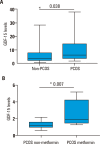GDF-15 levels in patients with polycystic ovary syndrome treated with metformin: a combined clinical and in silico pathway analysis
- PMID: 39420932
- PMCID: PMC11460967
- DOI: 10.20945/2359-4292-2023-0416
GDF-15 levels in patients with polycystic ovary syndrome treated with metformin: a combined clinical and in silico pathway analysis
Abstract
Objective: Polycystic ovary syndrome (PCOS) is an endocrine disease characterized by metabolic, reproductive, and psychological manifestations. Growth and differentiation factor 15 (GDF-15) is a cytokine associated with metabolic and inflammatory disorders. Metformin is commonly used for the treatment of PCOS. We investigated the relationship between GDF-15 levels and PCOS, the effect of metformin on GDF-15 levels, and potential biologic pathways related to GDF-15.
Subjects and methods: The study included 35 women with PCOS and 32 women without PCOS (controls). Both groups were compared in terms of GDF-15 levels. Additional analysis was conducted on samples from 22 women with PCOS who were treated with either metformin (n = 7) or placebo (n = 15), retrieved from a previous randomized, controlled trial. Levels of GDF-15 were measured using MILLIPLEX. The biologic pathways related to GDF-15 were evaluated using the databases STRING, SIGNOR, and Pathway Commons. The statistical analysis was conducted using the software SPSS.
Results: Levels of GDF-15 were higher in the PCOS group compared with the non-PCOS group (p = 0.039). Among women with PCOS, GDF-15 levels were higher in those treated with metformin compared with placebo (p = 0.007). The proteins related to GDF-15 overlapped between the databases, and a significant interaction was found between GDF-15 and proteins related to PCOS and its complications, including those related to estrogen response, oxidative stress, ovarian infertility, interleukin (IL)-18, IL-4, the ratio of advanced glycation end products to their receptor (AGE/RAGE), leptin, transforming growth factor beta (TGF-β), adipogenesis, and insulin.
Conclusion: The findings of the present study suggest a relationship between GDF-15 and PCOS and a potential increase in GDF-15 levels with metformin treatment. An additional finding was that GDF-15 could be involved in biologic pathways related to PCOS complications.
Keywords: GDF-15; biologic pathways; metformin; polycystic ovary syndrome.
Conflict of interest statement
Disclosure: no potential conflict of interest relevant to this article was reported.
Figures


Similar articles
-
Acupuncture treatment for insulin sensitivity of women with polycystic ovary syndrome and insulin resistance: a study protocol for a randomized controlled trial.Trials. 2017 Mar 9;18(1):115. doi: 10.1186/s13063-017-1854-2. Trials. 2017. PMID: 28274268 Free PMC article. Clinical Trial.
-
Regulation of circulating CTRP-2/CTRP-9 and GDF-8/GDF-15 by intralipids and insulin in healthy control and polycystic ovary syndrome women following chronic exercise training.Lipids Health Dis. 2021 Apr 19;20(1):34. doi: 10.1186/s12944-021-01463-3. Lipids Health Dis. 2021. PMID: 33874963 Free PMC article. Clinical Trial.
-
Effect of long-term treatment with metformin added to hypocaloric diet on body composition, fat distribution, and androgen and insulin levels in abdominally obese women with and without the polycystic ovary syndrome.J Clin Endocrinol Metab. 2000 Aug;85(8):2767-74. doi: 10.1210/jcem.85.8.6738. J Clin Endocrinol Metab. 2000. PMID: 10946879 Clinical Trial.
-
Endocrine and metabolic characteristics in polycystic ovary syndrome.Dan Med J. 2016 Apr;63(4):B5232. Dan Med J. 2016. PMID: 27034186 Review.
-
Metformin treatment before and during IVF or ICSI in women with polycystic ovary syndrome.Cochrane Database Syst Rev. 2020 Dec 21;12(12):CD006105. doi: 10.1002/14651858.CD006105.pub4. Cochrane Database Syst Rev. 2020. PMID: 33347618 Free PMC article.
Cited by
-
Melatonin from Plants: Going Beyond Traditional Central Nervous System Targeting-A Comprehensive Review of Its Unusual Health Benefits.Biology (Basel). 2025 Jan 30;14(2):143. doi: 10.3390/biology14020143. Biology (Basel). 2025. PMID: 40001911 Free PMC article. Review.
References
Publication types
MeSH terms
Substances
LinkOut - more resources
Full Text Sources
Medical
Miscellaneous
